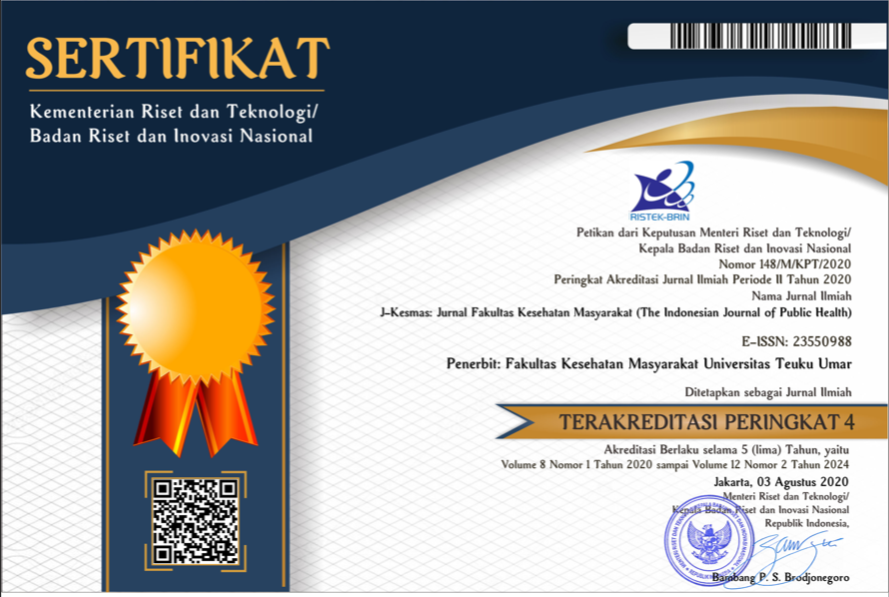Influence of Personal Hygiene on Stunting Occurrence
Abstract
Stunting is a significant problem that Indonesia must overcome to produce an excellent cognitive and physical development generation. Stunting is a problem in Bireuen Regency, Indonesia, and must be managed because it has long-term impacts on the future generation. According to data from the World Health Organization (WHO), in 2017, Indonesia had the third-highest stunting prevalence rate globally, at 32.6%. Even though the stunting prevalence rate in Indonesia decreased from 37.2% in 2013 to 27.7% in 2018, it is still far from the WHO target of not exceeding 20%. Therefore, the government is making efforts to rates s rate e reduce the prevalence of stunting in Indonesia by issuing The Regulation of the Republic of Indonesia’s President Number 72 the Year 2021 about the acceleration of stunting decrease. Based on the result of a nutrition case study of Indonesia in 2021, Aceh’s stunting rate reached 33,18% until it was included among the seven provinces with the highest stunting cases in Indonesia. One of the regencies in Aceh Province that needs immediate solutions to solve stunting is Bireuen Regency. The purpose of this research was to find out the influence of personal hygiene on stunting occurrence. The study used an analytical, quantitative method with a cross-sectional approach. This method aims to analyse the impact of personal hygiene on stunting occurrence in Pandrah Sub District Bireuen Regency. The sample selection technique in this research was the entire population, namely 62 people. Based on the research conducted in Pandrah Sub District, Bireuen Regency, the research results showed that personal hygiene had a significant influence on stunting occurrence, with a p-value of 0.001 (which is less than the significance level of 0.05). It could be concluded that personal hygiene significantly influences stunting occurrence.
Keywords
Full Text:
PDFReferences
Access, O. (2017). Hubungan Riwayat Penyakit Diare dan Praktik Higiene dengan Kejadian Stunting pada Balita Usia 24-59 Bulan di Wilayah Kerja Puskesmas Simolawang, Surabaya The Relations Between Diarrheal Disease History and Hygiene Practices with Stunting Incidences Among. 243–251.
https://doi.org/10.20473/amnt.v1.i3.2017.243-251
Apriluana, G., & Fikawati, S. (2018). Analisis Faktor-Faktor Risiko terhadap Kejadian Stunting pada Balita (0-59 bulan) di Negara Berkembang dan Asia Tenggara. Jurnal Media Litbangkes, Vol. 28 No. 4,253. WHO. (2017). Levels and trends in child malnutrition. Geneva.
Bella, Febriani Dwi. 2019. Hubungan Pola Asuh dengan Kejadian Stunting Balita dari Keluarga Miskin di Kota Palembang. Jurnal Gizi Indonesia (The Indonesian Journal of Nutrition). Vol.8, No.1: 31-39
Hossain, S., Ahmed, F., Hossain, S., & Sikder, T. (2018). Nutritional Status and Basic Hygiene Practices of Rural School Age Children of Savar Region, Dhaka, Bangladesh. Central Asian Journal of Global Health, 7(1). https://doi.org/10.5195/cajgh.2018.282
Kusuma, A. N. (2019). Determinan Personal Hygiene Pada Anak Usia 9–12 Tahun. Faletehan Health Journal, 6(1), 37–44. https://doi.org/10.33746/fhj.v6i1.47.
Laili, A. N. (2018). Pengaruh Sanitasi di Lingkungan Tempat Tinggal terhadap Kejadian Stunting pada Balita (Studi di Wilayah Kerja Puskesmas Sumberjambe, Puskesmas Ksiyan dan Puskesmas Sumberbaru Kabupaten Jember. Jurnal Kebidanan, 8(1), 28–32.
Liviana, P., Hermanto, & Pranita. (2019). Karakteristik Orang Tua dan Perkembangan Psikososial Infant. Jurnal Kesehatan Vol. 12, No. I, 2.
Nasrul. (2018). Pengendalian Faktor Risiko Stunting Anak Balita di Sulawesi Tengah. Jurnal Kesehatan Masyarakat, Vol 8 No. 2, 131-146
Nuraina, N., Sunarsih, T., & Astuti, D. (2022). Perceptions of Pregnant Mothers in Stimulating the Fetus. Indonesian Journal of Global Health Research, 4(4), 837-844. https://doi.org/10.37287/ijghr.v4i4.1324
Peraturan Bupati Bireuen Nomor 30 Tahun 2020 tentang Peran Gampong dalam Penurunan Stunting.
Riset Kesehatan Dasar (Riskesdas). (2018). Badan Penelitian dan Pengembangan Kesehatan Kementerian RI.
Saputra, R. (2019). Faktor yang Berhubungan dengan Kepemilikan Jamban Keluarga dan Personal Hygiene di Desa Kuala Lama Tahun 2018. Fakultas Kesehatan Masyarakat Universitas Sumatera Utara, 22
Sinatrya, A. K., & Muniroh, L. (2019). Hubungan Faktor Water, Sanitation, dan Hygiene (WASH) dengan Stunting di Wilayah Kerja Puskesmas Kotakulon . Amerta Nutrition, 166-167
Studi Kasus Gizi Indonesia. (2021). https://www.litbang.kemkes.go.id/buku-saku-hasil-studi-status-gizi-indonesia-ssgi-tahun-2021.
Uliyanti, Tamtomo, D. G., & Anantanyu, S. Faktor yang Berhubungan dengan Kejadian Stunting pada Balita Usia 24-59 Bulan. Jurnal Vokasi Kesehatan, 3(2), 67–77. http://ejournal.poltekkes- pontianak.ac.id/index.php/JVK. 2017
DOI: https://doi.org/10.35308/j-kesmas.v10i1.7363
Refbacks
- There are currently no refbacks.
Managed by Fakultas Kesehatan Masyarakat
Published by Universitas Teuku Umar
Website: http://jurnal.utu.ac.id/jkesmas
Email: jkemas@utu.ac.id 
This work is licensed under a Creative Commons Attribution-ShareAlike 4.0 International License.







.jpg)


